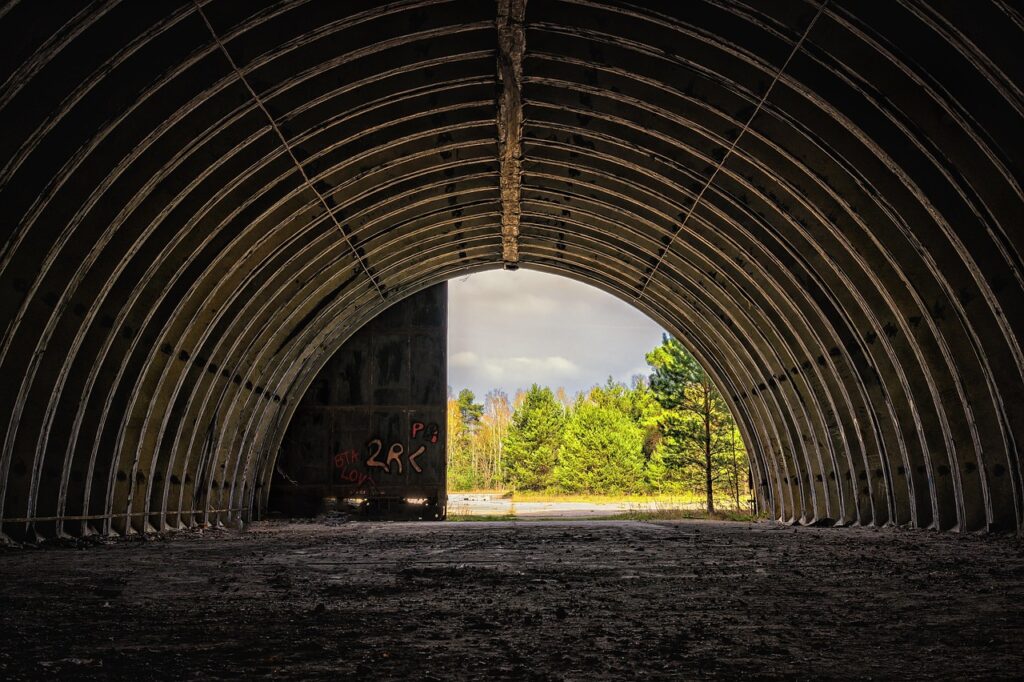If you have not heard about clear-span buildings, you are not alone.
Clear span buildings are structures that feature a wide open space without any interior columns or supports. This design maximizes usable floor space and creates a versatile environment that can be adapted for various functions.
Clear span construction is commonly used in aircraft hangars, sports facilities, warehouses, manufacturing plants, and agricultural storage buildings. The main purpose is to eliminate obstructions within the structure, allowing for the full interior area to be used freely.
The clear span concept relies heavily on the strength of the materials and the engineering behind the structure. Steel is the most popular material for this type of building because it can support long distances without the need for internal supports. This results in a streamlined and efficient design that does not compromise the building’s structural integrity. The roof load is distributed across the entire span and supported by the exterior walls or rigid frames, which allows the interior to remain open and uncluttered.
The folks at Lion Barns have put together this article to explain more about clear span buildings.
Read on.
Advantages of a Column Free Interior
One of the most notable benefits of a clear span building is the absence of interior columns. This makes it ideal for any operation that requires open space, such as indoor sports, vehicle storage, or large-scale equipment movement. Uninterrupted space improves workflow, increases storage capacity, and allows more flexibility in layout planning. It becomes easier to accommodate different machinery setups or reconfigure spaces without having to work around structural posts.
Businesses that require efficient storage and inventory systems often prefer clear span buildings. The ability to move goods, install shelving, or use forklifts without spatial limitations boosts productivity. In recreational settings, such as gymnasiums or skating rinks, open space enhances safety and function. For events and exhibitions, the open interior allows for a more customizable and immersive experience.
Applications in Various Industries
Clear span buildings are used across numerous industries due to their adaptability and strength. In aviation, hangars must accommodate the wingspans of large aircraft, making an open interior critical. The same need applies to agricultural facilities where large tractors and equipment must be stored or maintained. In commercial and industrial applications, these buildings can house large machinery or serve as manufacturing floors where mobility is essential.
The retail sector also benefits from clear span designs. Big box stores and wholesale outlets use them to create open showrooms and merchandising floors. Educational institutions have used clear span architecture to design auditoriums, gymnasiums, and multi-purpose halls. These structures are also popular in the entertainment and event sectors, where flexibility and open layout are vital for stage setups and seating arrangements.
Structural Engineering and Design Considerations
Creating a clear span building involves careful planning and specialized engineering. The most critical aspect is the span length, which can range from small garages to massive aircraft hangars. The wider the span, the more demanding the structural design becomes. Engineers must calculate load distribution, wind resistance, and snow load based on the geographical location and intended use.
Steel trusses or rigid frames are typically employed to support the wide roof. These components are designed to bear weight and transfer it to the building’s outer edges. Roof pitch, wall bracing, and foundation strength are essential factors. Attention to detail in the design phase ensures the building remains stable and durable over time. Computer aided design software helps architects visualize the structure and make accurate adjustments before construction begins.
Material Choices and Durability
Steel is the material of choice for most clear span buildings because of its strength and durability. It resists environmental stress, pests, and decay much better than wood. Steel can support longer spans without warping or sagging, making it ideal for clear span applications. Galvanized or coated steel provides added protection against rust and corrosion, which extends the building’s lifespan.
The use of pre engineered steel components speeds up the construction process. These components are fabricated off site and assembled quickly on location. This approach reduces labor costs and minimizes delays. Steel structures are also fire resistant and can be designed to meet strict safety codes. When maintained properly, a steel clear span building can last for decades with minimal upkeep.
Customization and Flexibility
Clear span buildings offer exceptional flexibility in design and usage. The absence of internal support allows for more creative freedom in planning interior layouts. Walls can be added or removed without affecting the structural integrity. This makes clear span structures an excellent choice for businesses that anticipate changes in operation or expansion in the future.
Customization options include varying roof styles, insulation levels, door placements, and window configurations. The exterior can be clad in metal panels, brick veneer, or other materials to match aesthetic preferences or comply with zoning requirements. Mezzanine levels can also be added to create second floor space without altering the clear span feature of the ground level.
Construction Process and Time Frame
The construction of a clear span building generally follows a straightforward process. Once the design and engineering plans are finalized, the site is prepared with a level foundation. Pre-engineered components arrive on site and are assembled according to the blueprint. Steel columns and frames are erected first, followed by the roof and wall panels. The building is then finished with doors, windows, and interior fittings.
Because many clear span buildings use prefabricated parts, the time frame for construction is usually shorter than traditional builds. This is beneficial for companies or organizations that require quick project turnaround. Weather delays are also less problematic since steel components can be installed in various conditions without compromising quality.
Cost Considerations and Return on Investment
Initial costs for a clear span building depend on its size, complexity, and customization. While the price may be higher than standard structures with interior supports, the long term savings often outweigh the upfront investment. Reduced maintenance, energy efficiency, and flexibility in usage all contribute to a strong return on investment.
Owners also benefit from lower insurance premiums due to the fire resistance and structural integrity of steel. Energy costs may decrease when proper insulation and ventilation are installed. The increased floor space and usability can improve revenue opportunities for commercial operations, making clear span buildings a smart financial decision over time.
Future Trends in Clear Span Construction
Advances in materials and design are expanding the potential for clear span buildings. New steel alloys, insulation technologies, and design software are making these structures more efficient and sustainable. Green building practices, including solar panel integration and water collection systems, are being adopted in clear span designs to meet environmental goals.
Modular construction methods are also gaining popularity. Builders can create large spans using modules that are shipped and assembled quickly. This speeds up projects and reduces waste. As demand for flexible, open spaces grows, clear span buildings will continue to evolve in form and function. They are no longer limited to industrial use but are being embraced in modern architectural applications.
Conclusion
Clear span buildings represent a significant advancement in construction design. Their ability to provide wide open spaces without interior obstructions makes them valuable in a range of industries. Steel framing, engineered design, and adaptable layouts ensure that these structures meet the needs of modern businesses and institutions. From sports arenas to storage facilities, clear span buildings offer a combination of strength, efficiency, and versatility that is difficult to match. As innovation continues, their role in architecture and infrastructure is expected to expand even further.

